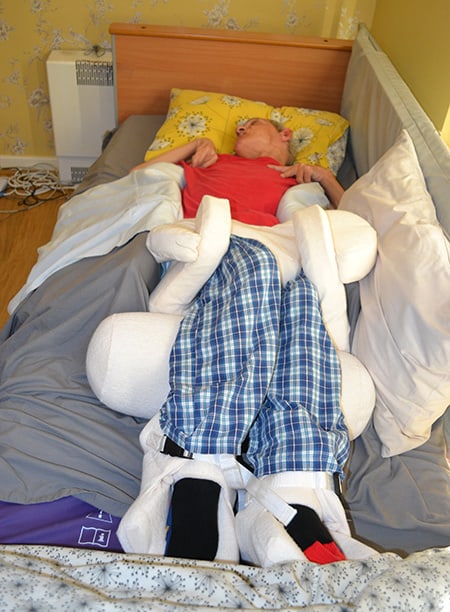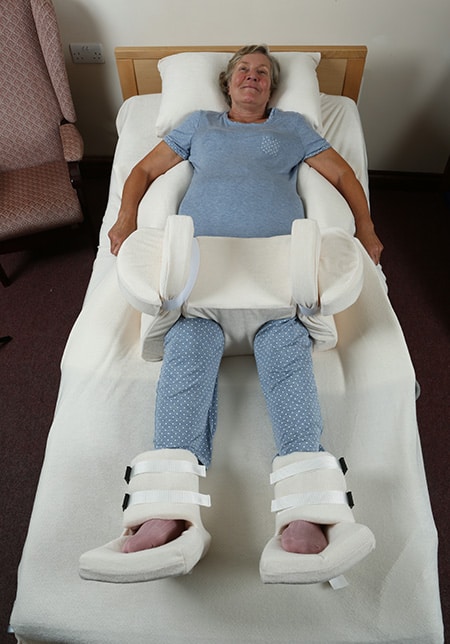The importance of night time positioning in a care home environment
 By Anna Waugh, Managing Director, Simple Stuff Works
By Anna Waugh, Managing Director, Simple Stuff Works
There is often a perception that as people grow older and become less mobile or develop conditions such as MS and Dementia their body shape will change. As an individual loses mobility their body becomes vulnerable to adopting damaging positions which can cause their body to change shape over time leading to secondary complications. Simple changes such as shortening of the hamstrings leading to hip and knee contractures have a devastating impact on a person’s ability to stay mobile, to adopt different postures and to sit and lie comfortably. However, these changes are often avoidable and can be prevented with the right therapeutic interventions, according to Anna Waugh, from Simple Stuff Works.
If we are going to be successful in protecting an individual’s body shape, we need to, first of all, identify who is at risk. Companies such as Simple Stuff Works are ultimately working towards prevention of body shape changes in the first place. We are often getting asked to see people and supply equipment for individuals for whom body shape distortion, such as hip and knee contractures, have already happened. Ideally, we would like there to be a level of knowledge, especially of people working in care homes, where people understand the person they are supporting has movement difficulties and is therefore at risk of potential body shape changes.
An individual’s mobility is a key indicator of risk if the person uses a wheelchair or requires hoisting. The risk they face is high and the challenge we face is the acceptance that the resulting complications are inevitable. Changes in body shape are an avoidable, expensive and painful secondary complication associated with movement difficulties. Inroads are being made though and the way we approach this issue is to offer training to key staff members such as Lorna Peake, Service Leader. Lorna attended a Simple Stuff Works train the trainer course and this provided her with the necessary awareness and knowledge to pass her training onto her staff to help them understand the importance of postural care and night time positioning.
 “One of our residents at Lily Marriot House, Anthony, has Cerebral Palsy, he has profound learning disabilities and does not use words to communicate. He also has severe body shape changes. From my experience of working with companies such as Simple Stuff Works, I knew immediately that Anthony would benefit from the use of a Positioning System. Anthony has now been using their Positioning System for six months; he now sleeps on his back which is much better than sleeping on his side like he used to. He also appears to be far more comfortable and is easier to position,” commented Lorna.
“One of our residents at Lily Marriot House, Anthony, has Cerebral Palsy, he has profound learning disabilities and does not use words to communicate. He also has severe body shape changes. From my experience of working with companies such as Simple Stuff Works, I knew immediately that Anthony would benefit from the use of a Positioning System. Anthony has now been using their Positioning System for six months; he now sleeps on his back which is much better than sleeping on his side like he used to. He also appears to be far more comfortable and is easier to position,” commented Lorna.
It is vital that staff learn to work together. Training is really important here because sometimes you have different support workers going to see the same person and they will often have their own way of undertaking certain care related tasks so there is a risk of limited continuity. This may not always the case but we must recognise that it is on occasions. Consistent training, such as the accredited online e-learning package developed by Simple Stuff Works, is key to standardising the approach used across care teams and ensuring people are getting the right information and support.
It is essential to work with people who know the individual really well and to make sure that the positioning strategy is gentle, safe and humane. Wherever possible, families should be involved and their valuable knowledge recognised. When therapy services supply positioning equipment, they are supplying a whole package; it cannot be a case of delivering the system and leaving the staff to it. Things to consider include whether the staff have sufficient knowledge and whether they can put together a thorough safety plan which addresses potential risks. Success comes about when we combine the expertise in the use of the equipment, the therapist’s extensive knowledge of biomechanics and the compassion and dedication of care home staff who have extensive knowledge about the person.
How has night time positioning evolved over the last 30 years:
 Back in the 1990s there was very little regard given to night time positioning, many people intuitively applied common sense and did the best they could to stop contractures by using pillows, teddies, towels etc. but it is only in the last 30 years or so that positioning equipment has started to be readily available, sensitively designed with people in mind, and therefore more widely used. Around the country, you will find some areas where people really understand the need for night time positioning, but in other areas, the knowledge is still limited. One reason for this could be that in some areas you may have one really enthusiastic therapist or nurse who has understood it, seen the need for it and ensured that it is an integral part of the care package, but the danger is if that therapist or nurse moves on their expertise are lost. We need postural care to be everybody’s business, as well understood and accepted as pressure care. We need residential care home managers and staff to understand it and embed it within their practice so if one person moves on the team can continue to provide effective care.
Back in the 1990s there was very little regard given to night time positioning, many people intuitively applied common sense and did the best they could to stop contractures by using pillows, teddies, towels etc. but it is only in the last 30 years or so that positioning equipment has started to be readily available, sensitively designed with people in mind, and therefore more widely used. Around the country, you will find some areas where people really understand the need for night time positioning, but in other areas, the knowledge is still limited. One reason for this could be that in some areas you may have one really enthusiastic therapist or nurse who has understood it, seen the need for it and ensured that it is an integral part of the care package, but the danger is if that therapist or nurse moves on their expertise are lost. We need postural care to be everybody’s business, as well understood and accepted as pressure care. We need residential care home managers and staff to understand it and embed it within their practice so if one person moves on the team can continue to provide effective care.
On the whole, we are starting to see more understanding of the need to position people therapeutically at night hence we are seeing more positioning systems going into residential care homes which are great. The need for night-time positioning in care homes is bigger than many realise. Preventing body shape distortion makes a huge difference to every aspect of a person’s life. They will be more comfortable, caring for them will be easier and more dignified and it can also prevent secondary health complications such as chest distortion and subsequent breathing problems and pneumonia.
The Simple Stuff Works sleep positioning system has been designed to offer a comfortable, hygienic and safe to use solution whilst helping people of all ages, at any time of the day or night to maintain a position which reduces the risk of body shape distortion. The system can play an integral part in the person’s ongoing therapy regime.
The base of the system comprises two layers of non-slip mesh between which supports are placed around the individual. The supports can be lateral supports, wedges, pillows or teddy bears, ensuring that this therapeutic positioning system is the most versatile solution available. As there is no noise, there is a greatly reduced chance of the person being disturbed if they need to be repositioned during the night. Hygiene is of paramount importance and the therapeutic positioning system from Simple Stuff Works contains silver which has been proven to actively combat communicable diseases such as MRSA, Salmonella and E-Coli through the application of SteriTouch. SteriTouch is made up of a range of antimicrobial additives which reduce the growth of harmful organisms including bacteria, mould and fungi.
Simple Stuff Works is an award winning organisation. The Positioning System won the British Healthcare Trade Association Independent Living Design Award in 2011 for its simplicity and ease of use. In the last 12 months Simple Stuff Works has not only won the British Healthcare Trades Association Best Established Product Award in 2015 and the Tamworth Business Awards 2015 for Manufacturer of the Year but the company was also a finalist in the Staffordshire Business Awards International Trade Category, only just losing out to pottery giant, Portmeirion.
For more information about training available from Simple Stuff Works, call 01827 307 870 or visit www.simplestuffworks.co.uk

